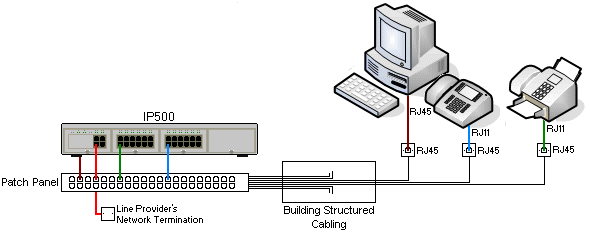The IP Office systems are designed primarily for use within an RJ45 structured cabling system using CAT3 unshielded twisted-pair (UTP) cabling and RJ45 sockets.
A structured cabling system is one where cables are run from a central RJ45 patch panel in the communications/data room to individual RJ45 sockets at user locations. All wires in each cable between the patch panel and the desk socket are connected straight through. This arrangement allows devices connected at the patch panel to be swapped to match the type of device that needs to be connected at the user socket. For example, making one user socket a phone port and another user socket a computer LAN port, without requiring any rewiring of the cables between the patch panel and the user location.

•Traditional IDC Punchdown Wiring Installations
Where necessary, the far end RJ45 plug can be stripped from IP Office cables and wired into traditional wiring systems using punch-block connectors. This type of installation should be performed by an experienced wiring technician.
•Trunk Connections
The majority of IP Office trunk ports use RJ45 connectors for acceptance of an RJ45-to-RJ45 cable. However, connection at the line provider's end may require use of a different plug type in order to match the line providers equipment.
•RJ11 Phone Connectors
Many phones use RJ11 sockets and are supplied with RJ11-to-RJ11 cables. RJ11 plugs can be inserted into RJ45 sockets and in many case the connection will work. However this is not recommended or supported as the connection lock is not truly positive and may become disconnected. An RJ45-to-RJ11 cable is available for these connections.
Avaya IP Office Cables
The following are Avaya supplied cables available for use with IP Office systems. The maximum length is applicable if the standard Avaya cable is replaced (if allowed) with an alternate non-Avaya cable.
Cable |
Description |
SAP Code |
Standard Length |
Maximum Length |
Connects to control unit RS232 DTE port. 9-Way D-type plug to 9-way D-type socket. |
– |
2m/6'6''. |
2m/6'6''. |
|
Connects from RJ45 sockets to RJ11 socketed DS and analog phones. |
TT700047871 |
4m/13'2''. |
See table below. |
|
Connects BRI/PRI trunk ports to the line provider's network termination point. RJ45 to RJ45. Red. |
700213440 |
3m/9'10''. |
– |
|
Connects the control unit to expansion modules. RJ45 to RJ45. Blue. |
700213457 |
1m/3'3''. |
1m/3'3''. |
|
Connects from IP Office LAN ports to IP devices. RJ45 to RJ45. Grey. |
700213481 |
3m/9'10''. |
100m/328'. |
The table below details the maximum total cable distances for non-IP extensions using different cable thicknesses. Cabling should be Category-1 unshielded twisted pair cable or better.
Telephone |
Unshielded Twisted-Pair (UTP) - 50nf/Km |
||
AWG22 |
AWG24 |
AWG26 |
|
1400 Series |
1200m/3937' |
1000m/3280'. |
670m/2200' |
9500 Series |
1200m/3937' |
1000m/3280' |
670m/2200' |
Analog Phones |
1000m/3280' |
1000m/ 3280' |
400m/1312' |
ETR Phones |
305m/1000' |
305m/1000' |
122m/400' |
